تخيل أنك في المدرسة الإعدادية وقد بدأت للتو في علم المثلثات. تجد نفسك عالقًا في إحدى المسائل، ولكن بدلًا من طلب التوضيح من معلمك، تختار الانتقال إلى المسألة التالية.
والنتيجة؟ ينتهي بك الأمر بعدم التعلم من التحدي ومعالجة المسائل اللاحقة بفجوة معرفية، مما يؤدي إلى ضعف الأداء.
تشبه تحديات العمل إلى حد كبير هذه الدروس غير الواضحة. إذا لم تقم بما يلي الوصول إلى جذور المشكلة ، فلن تكون قادرًا على تحسين منتجاتك وخدماتك وعملياتك الداخلية ومواءمتها مع أهداف شركتك في النمو والربحية. ولكن كيف نفعل ذلك؟
إن كلاً من ملاحظات العملاء والموظفين أمر بالغ الأهمية لتحسين استراتيجيات العمل، ولكن من الصعب بناء منظومة التغذية الراجعة الصحيحة. وهنا بالتحديد يأتي دور حلقات التغذية الراجعة التي تساعد في توظيف الرؤى البناءة من العملاء والموظفين لتعزيز الاحتفاظ بالعملاء ورعاية قوة عاملة عالية الأداء.
نستكشف في هذا المقال ما يلي:
- ما هو مفهوم حلقات التغذية الراجعة (بمساعدة أمثلة عملية)
- كيفية تشغيل حلقات التغذية الراجعة الفعالة
ما هي حلقة التغذية الراجعة؟
حلقة التغذية الراجعة هي في الأساس عملية تحسين عمليات الشركة أو منتجاتها أو خدماتها من خلال المدخلات البناءة. وهي تشمل جمع التغذية الراجعة من العملاء أو الموظفين أو أصحاب المصلحة، وتحليل بياناتهم، وتطبيق الرؤى لتحسين جودة القرارات التجارية .
يمكن العثور على أساسيات حلقات التغذية الراجعة في كتاب رائد الأعمال الشهير إريك ريس بعنوان الشركة الناشئة المرنة الذي يسلط الضوء على كيفية اتباع الشركات الناشئة لحلقة التغذية الراجعة بناء-قياس-تعلم-التعلم لتحليل ردود أفعال العملاء ثم اتخاذ قرار بالتحول أو الاستمرار. والفكرة هي:
- البناء: تحويل الفكرة إلى شيء جذاب للعملاء
- الاختبار: قياس رضا العملاء
- التحسين: أخذ الدروس المستفادة من ملاحظات العملاء والعودة إلى إعادة بناء المنتج أو إنشاء منتج جديد - وهكذا تستمر الحلقة. تشير حلقة التغذية الراجعة المغلقة إلى أنك نجحت في حل مشكلة مستمرة من خلال دمج ملاحظات المستخدمين
هذا مثال على حلقة تعليقات العملاء، لكن الشركات تستخدم قنوات متعددة من حلقات التعليقات لدمج التغييرات. إليك بعض الأمثلة:
- حلقة التغذية الراجعة للموظفين: هنا، يسأل المديرون الموظفين عن مستويات رضاهم الوظيفي الحالية وإجراء أي تغييرات مطلوبة على سياسات الاحتفاظ بالموظفين ومزايا الموارد البشرية وما إلى ذلك. يمكن للموظفين أيضًا أن يكونوا في الطرف المتلقي للتغذية الراجعة
- حلقة التغذية الراجعة الإبداعية: تُستخدم عادةً في مشاريع التصميم وتجربة المستخدم. ويتطلب كلمحتوى إبداعي أن يكونتحليلها من قبل أصحاب المصلحة ومراجعتها حتى تلبي متطلبات العميل
- حلقة التغذية الراجعة للتطوير: التغذية الراجعة المأخوذة من المستخدمين النهائيين للتطبيق أو الموقع الإلكتروني المطور حديثًا. يتم استخدام المدخلات لتحسين تجربة المستخدم
بعض المقاييس القياسية المستخدمة في حلقات التغذية الراجعة تشمل نقاط جهد العميل (CES)، ونقاط رضا العملاء (CSAT)، والإيرادات لكل موظف (RPE)، وصافي نقاط المروجين (NPS)، ومعدل دوران الموظفين (ETR).
أنواع حلقات التغذية الراجعة
عند مناقشة حلقات التغذية الراجعة، هناك نوعان رئيسيان يجب مراعاتهما: حلقات التغذية الراجعة الإيجابية والسلبية.
حلقات التغذية الراجعة الإيجابية
تهدف حلقات التغذية الراجعة الإيجابية إلى تعزيز وتضخيم سلوك معين أو عمل معين من خلال التكرار أو الدورات المستمرة، مما يفرض التغيير السريع ويعزز المخرجات. والفكرة هي أن تقوم الشركات بتحديد نقاط قوتها والاستفادة من مجالات التميز تلك لزيادة قدرتها التنافسية.
على سبيل المثال، يسعى عمالقة الأعمال مثل Airbnb وAmazon إلى تعليقات المستخدمين بطرق مختلفة للمساعدة في التخطيط الاستراتيجي المبادرات. من خلال تضخيم الاستراتيجيات الناجحة، يمكن لهذه المنظمات تسريع خطط النمو وتعزيز الابتكار.
من وجهة نظر مكان العمل، عندما تقوم بجمع الملاحظات حول الجوانب الإيجابية لثقافة الشركة، تكتشف ما يساهم في الاحتفاظ بالموظفين. علاوة على ذلك، فإن رفع مستوى سعادة الموظفين ومشاركتهم يمكن أن يعزز الإنتاجية والأرباح بشكل ملحوظ.
حلقات التغذية الراجعة السلبية
حلقات التغذية الراجعة السلبية - وتسمى أيضًا حلقات التغذية الراجعة المتوازنة، تهدف إلى تصحيح أو مواجهة إجراء أو سلوك غير مرغوب فيه. على سبيل المثال، إذا أبلغ العديد من العملاء عن خطأ مزعج في تطبيق جديد، يستخدم المطورون هذه التغذية الراجعة لمعالجة هذا الخطأ ومنع تكراره.
تعمل هذه الحلقات بمثابة فحص واقعي للمتلقي، والذي يمكن أن يكون مدير المشروع أو أحد الموظفين أو الفريق بأكمله. على الرغم من أنها تسلط الضوء في البداية على عدم رضا العملاء أو المشاكل غير السارة، إلا أنها تؤدي في الغالب إلى نتائج إيجابية.
على سبيل المثال، تؤدي حلقات التغذية الراجعة السلبية للعملاء إلى حل سريع للمشكلات وتحسين جودة المنتج، مما يعزز رضا العملاء وولاءهم بشكل عام.
ويتطلب تشغيل حلقات التغذية الراجعة السلبية للموظفين إدراك السلوك غير المرغوب فيه ذي النتيجة السلبية، مما يمهد الطريق لاتخاذ إجراءات تصحيحية. على سبيل المثال إذا تأخرت في الإبلاغ عن خطأ ما (_ سلوك غير مرغوب فيه)، يجب تأجيل إطلاق المنتج ( نتيجة سلبية)
3 فوائد حلقات التغذية الراجعة الإيجابية ## 3 فوائد حلقات التغذية الراجعة الإيجابية
يمكن أن تكون حلقات التغذية الراجعة الإيجابية تجربة ممتازة لأصحاب العمل والموظفين والعملاء على حد سواء. فيما يلي الفوائد الثلاث الرئيسية المتوقعة:
1. تعزيز الروح المعنوية في مكان العمل
حلقات التغذية الراجعة الإيجابية محورية في تعزيز معنويات الموظفين وتعزيز ثقافة العمل الصحية.
عندما يجد الموظفون أن ملاحظاتهم تُحدث تغييرًا ملموسًا، فإنها تعزز الشعور بالقيمة والتقدير. ويميل الموظفون الذين يتم تقديرهم إلى أن يكونوا أكثر سعادة ومشاركة وإنتاجية بشكل ملحوظ. لهذا السبب 40% من المهنيين الآن يعطون الأولوية لثقافة الشركة عند اختيار وظائف جديدة .
نصيحة: هل تحتاج إلى طريقة سريعة للحصول على آراء الموظفين في فريقك؟ استخدم أداة قالب ملاحظات الموظف ClickUp لتتبع مشاعر الموظفين من خلال تصورات سهلة المتابعة.
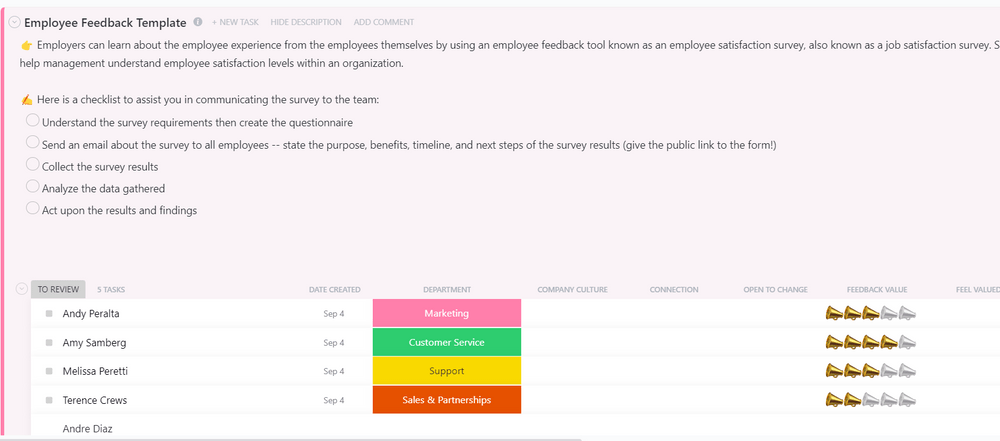
احصل على ملاحظات حقيقية وقابلة للتنفيذ من موظفيك في قالب واحد قابل للتتبع والتنظيم
2. انخفاض معدل دوران الموظفين
تساهم حلقات التغذية الراجعة الإيجابية في الحد من معدل دوران الموظفين من خلال معالجة المشاكل ببراعة وإظهار التزام الشركة بالتحسين. تشهد الشركات التي تدمج بفعالية التغذية الراجعة المنتظمة للموظفين تجربة مذهلة 14.معدل دوران أقل بنسبة 9% من أولئك الذين يتجاهلون مدخلات الموظفين .
3. تحسين الابتكار
تعمل حلقة التغذية الراجعة هذه كمحفز للابتكار، مما يساعد الشركات على تلبية متطلبات السوق بشكل استباقي. فهي لا تحل المشاكل التي يبلغ عنها العملاء فحسب، بل تساعد أيضًا فريق المنتج على تحديد وترتيب الأولويات ميزات جديدة تلبي تفضيلات المستخدم.
أمثلة على حلقة التغذية الراجعة الإيجابية
يمكن أن تكون حلقة التغذية الراجعة الإيجابية داخل شركتك عملية رسمية حيث تلتمس بنشاط التغذية الراجعة من الموظفين أو العملاء. وبدلاً من ذلك، يمكن أن تكون عملية غير رسمية ومستمرة حيث يتم قبول الملاحظات في أي وقت وفي كل مرة.
فيما يلي أمثلة بارزة توضح حلقات التغذية الراجعة الإيجابية الناجحة في أماكن عمل مختلفة.
نتفليكس تستخدم شبكة البث العملاقة حلقة تعليقات داخل التطبيق لتشغيل نظام توصيات قائمة المشاهدة. تقدم نتفليكس توصيات مخصصة من خلال خوارزميات تحلل
شخصية المستخدم وسجل المشاهدة والتفضيلات.
وقد ساهمت هذه الاستراتيجية في تكوين قاعدة هائلة من المشتركين في Netflix, تجاوز 232 مليون مشترك بحلول عام 2024 . بالإضافة إلى ذلك، فقد ساعدت الشركة في الحفاظ على معدل منخفض للتخبط في الصناعة خلال فترة الاضطرابات التي أعقبت الجائحة، مما ميزها عن المنافسين.
ديل من الأمثلة الجيدة على استخدام حلقة التغذية الراجعة للموظفين استراتيجية شركة Dell لأتمتة العملية بأكملها. فباستخدام شركة MonkeyLearn، وهي شركة برمجيات، أجرت شركة الكمبيوتر العملاقة استطلاعات الرأي الخاصة برضا أكثر من 10,000 موظف.
في وقت سابق، كانت شركة Dell تقوم بالمخطط بأكمله يدويًا، مما أضاف ضغطًا إضافيًا على بعض العاملين لتحليل البيانات وترتيبها وتقديمها بالكامل. مع وجود التكنولوجيا في الصورة، تمكنت Dell من تحليل جميع مستويات رضا الموظفين في غضون أسبوع واحد.
والنتيجة؟ حددت Dell الإيجابيات في مكان العمل وأجرت تغييرات في مجالات مثل الطعام ومنطقة الصالة الرياضية وقاعات الاجتماعات لإثارة إعجاب العاملين، كل ذلك مع توفير أكثر من 400 ساعة عمل للموظفين.
خطوط ساوث ويست الجوية منذ إنشائها كشركة طيران بأسعار معقولة في عام 1971، تطورت خطوط ساوث ويست الجوية باستمرار لتصبح شركة طيران بارزة، كما تطورت آلية التغذية الراجعة الخاصة بها. ✈️
في أيامها الأولى، كانت الشركة لا تحل المشكلات إلا بعد حدوثها. ومع ذلك، مع تقدم التكنولوجيا، أدركت شركة طيران ساوث ويست أن مشاركة الموظفين أمر حيوي لزيادة رضا العملاء. وقد أدى ذلك إلى قيام الشركة بتنفيذ آلية تغذية راجعة مستمرة حيث يمكن للمديرين والموظفين تقديم ملاحظات في الوقت الفعلي.
وساعدت هذه المبادرة المديرين على فهم ما يحتاجه الموظفون وتحديد العوامل الإيجابية التي أدت إلى الاحتفاظ بالمواهب على المدى الطويل في الفريق.
## 3 فوائد حلقات التغذية الراجعة السلبية
قد يكون لفوائد تشغيل حلقات التغذية الراجعة السلبية مقاصد مختلفة ولكنها تنبع من نفس المكان - التحسين. فيما يلي الفوائد الثلاث الأساسية المتوقعة
1. تحسين المنتجات والخدمات
تعد حلقات التغذية الراجعة السلبية مهمة لتحسين المنتجات والخدمات، لا سيما في قطاعات مثل تطوير البرمجيات، حيث يتم تحديد أولويات الميزات و تخطيط خارطة الطريق يمكن أن يستغرق وقتًا طويلاً ويستهلك الكثير من الموارد.
توفر هذه الحلقات اختصارًا من خلال الاستفادة من ملاحظات العملاء المباشرة. لا يحافظ التحسين المستمر لميزات المنتج على قدرة الشركات على المنافسة فحسب، بل يضمن أيضًا ملاءمتها في الأسواق الديناميكية.
تجمع العلامات التجارية الملاحظات السلبية من خلال طرق مباشرة مثل الاستبيانات أو بشكل غير مباشر من خلال مراقبة الإشارات الاجتماعية وجمع الرؤى من المناقشات العامة - مثل مراجعات المنتجات - حول عروضها.
إذا كنت تعمل مع منتج أو خدمة تتطور باستمرار، استخدم قالب خارطة طريق تطوير المنتج ClickUp خارطة طريق تطوير المنتج لتحديد الأهداف والغايات الخاصة بتحديثات الميزات وتصور اتجاه مرن بناءً على ملاحظات العملاء.
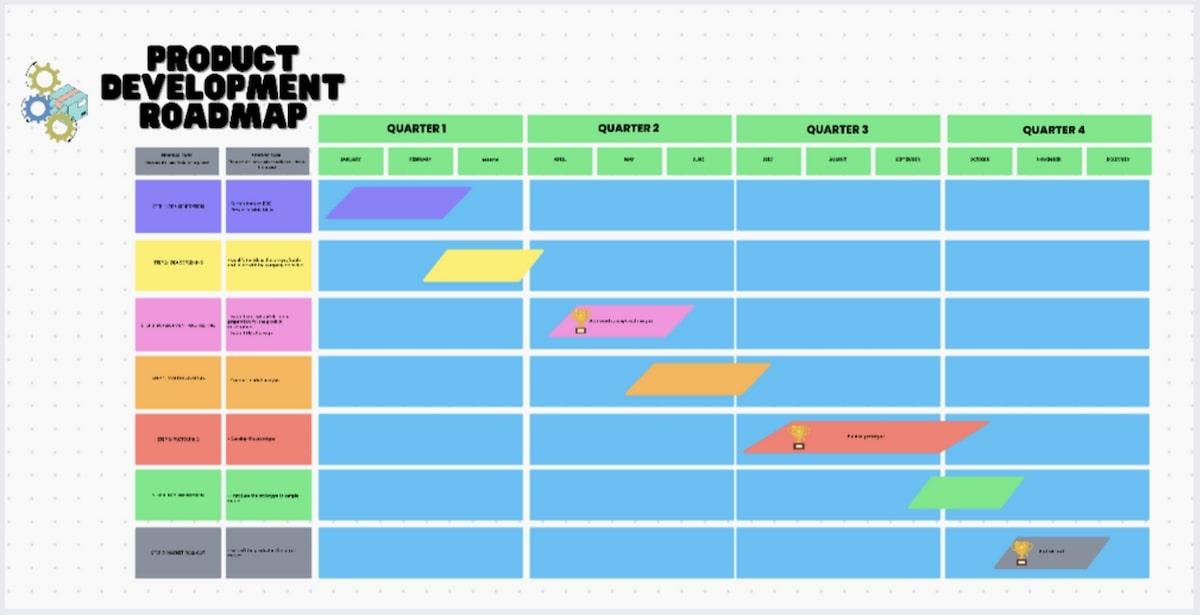
استخدم قالب السبورة البيضاء لخريطة طريق تطوير المنتج من ClickUp لتخطيط معالم تطوير منتجك وتتبعها والاحتفال بها بصريًا
2. الاحتفاظ بالعملاء
تتمثل النتيجة المباشرة للنقطة أعلاه في أن تنفيذ حلقات التغذية الراجعة السلبية يساعد في تحديد مجالات التحسين، مما يسمح للشركات باتخاذ إجراءات مستهدفة تلقى صدى لدى العملاء. يشير حل المشكلات بسرعة إلى الالتزام ويعزز ولاء العملاء.
3. التخفيف من الآثار السلبية للكلام الشفهي السلبي
نحن نعيش في عصر ثقافة الإلغاء حيث يمكن للعملاء مفرطي اليقظة أن يتحدوا معًا لهدم منتج أو خدمة بهاشتاج بسيط. يمكن أن يكون تجاهل العملاء غير الراضين مكلفًا، مع الأخذ في الاعتبار أن 26% من الأشخاص يمتنعون عن التعامل مع العلامات التجارية بسبب الكلام السلبي من الأصدقاء أو العائلة .
عندما يتم الاستفادة من حلقات التغذية الراجعة السلبية من قبل فرق التسويق والفرق الأخرى التي تتعامل مع العملاء، تعمل حلقات التغذية الراجعة السلبية كدرع ضد انتشار الكلام الشفهي السلبي وتمنع تآكل ثقة العملاء ومصداقيتهم.
أمثلة على حلقات التغذية الراجعة السلبية
اطلع على أمثلة لحلقات التغذية الراجعة السلبية ل Slack و Best Buy.
سلاك لوحظ مثال رائع للاستفادة من ملاحظات العملاء السلبية في Slack. وعلى الرغم من نموها، فإن الشركة تعطي الأولوية لتجربة المستخدم من خلال الانخراط بنشاط مع العملاء لفهم احتياجاتهم وتفضيلاتهم.
من خلال حلقة التغذية الراجعة السلبية، تراقب Slack بجدية ردود الفعل السلبية وتحللها، حتى عندما لا يتم تقديم طلبات تغيير صريحة. وقد عزز هذا الالتزام التوسع المستمر للمنصة.
في الواقع، عندما أصدر Slack منتج الحد الأدنى من القيمة (MVP) في عام 2013 ، تم منح عدد قليل فقط من الأشخاص إمكانية الوصول إلى ميزات معينة. وبالاستفادة من ملاحظاتهم من تجاربهم، تمكن Slack من زيادة الابتكار وإطلاق ميزات تواصل أفضل على مر السنين.
ويؤكد ستيوارت باترفيلد، الرئيس التنفيذي والشريك المؤسس لـ Slack، على هذا النهج - لذلك عادةً لا يكون الأمر مباشرًا... وبدلاً من ذلك، ننظر إلى كيفية استخدام الناس له [Slack]... في كثير من الأحيان، عندما يكون لدى الناس أسئلة، إما أنهم يطلبون توضيحًا لكيفية عمل شيء ما، أو أنهم يطلبون شيئًا جديدًا.
بيست باي تستخدم Best Buy، وهي واحدة من أكبر بائعي الإلكترونيات الاستهلاكية بالتجزئة في العالم، حلقة ردود الفعل السلبية لتعزيز تجربة العملاء.
في عام 2010، قدمت بست باي (صوت المستهلكين من خلال الموظفين)، وهي أداة بحثية مصممة الحصول على آراء العملاء المستهدفين والتظلمات - وهو في الأساس نظام حلقة تغذية راجعة سلبية.
عند تلقي ملاحظات VOCE، نفذت Best Buy تغييرات فورية لتحسين نموذج خدماتها. فقد قاموا بتبسيط طلبات الاستلام عبر الهاتف المحمول، وتوضيح الفروق بين خدمة العملاء وخدمات Geek Squad لإزالة الالتباس لدى العملاء، وتقديم صالة Geek Squad Lounge، التي تقدم مساعدة شخصية للعملاء قبل مغادرتهم المتجر.
كيف تدير حلقات التغذية الراجعة الفعالة
يعد تشغيل نظام حلقات التغذية الراجعة النوعية عملية متعددة المراحل تعتمد على عدة أدوات برمجية. ومن الشائع أن تستخدم الشركات حلولاً واسعة النطاق لجمع الملاحظات أو جمع البيانات وإدارة المشاريع لتنظيم كل شيء.
سنقوم بتفصيل الخطوات الأربع الأساسية لتنفيذ أي قناة لحلقة التغذية الراجعة في مؤسستك. ولتسهيل فهم العملية، سنقوم بعرض الميزات والوظائف داخل انقر فوق ، وهو حل شامل لإدارة العمل وإدارة علاقات العملاء يمكّنك من جمع الملاحظات وترتيبها والعمل من خلالها.
الخطوة 1: جمع التعليقات من خلال قنوات اتصال واضحة ومفتوحة
التواصل المفتوح والشفاف هو أساس النجاح التشغيلي في أي عمل تجاري. إنه يزيل الغموض، ويعزز الثقة، ويساعدك على إنشاء خرائط العمليات بسهولة أكبر.
الخطوة الأولى في بدء حلقة التغذية الراجعة هي تحديد قنوات الاتصال لجمع الملاحظات. فمعظم الشركات ترسل استمارات تغذية راجعة مخصصة إلى الجمهور المستهدف، سواء كان موظفين أو عملاء، لجمع الملاحظات.
انقر فوق المدمج في ClickUp عرض النموذج هي ميزة ممتازة لاستخدامها إذا كنت تتطلع إلى تبسيط إنشاء النماذج والاستبيانات. من خلال ميزة السحب والإفلات البديهية، يمكنك تخصيص النماذج لحالة الاستخدام الخاصة بك، مثل:
- ملاحظات المنتج
- طلبات تكنولوجيا المعلومات
- استبيانات الموظفين
- توجيه العملاء المحتملين للمبيعات
- الملاحظات والطلبات الإبداعية
عزز عملية حلقة الملاحظات عن طريق إضافة منطق شرطي إلى النماذج. يمكنك أيضًا استخدام ClickUp AI لتبادل الأفكار حول الأسئلة التي يجب تضمينها أو وضع استبيان الاستبيان بأكمله.
يمكنك تخصيص نماذجك باستخدام السمات والصور الرمزية لتتناسب مع تفضيلات العلامة التجارية. بمجرد إنشاء نموذج الملاحظات الخاص بك، شاركه مع الفرق الداخلية وأصحاب المصلحة، أو قم بنشره أو تضمينه على موقعك الإلكتروني.

مثال على المنطق الشرطي في نماذج النقر فوق نماذج ملاحظات المنتج
يمكنك أيضًا الاستفادة من العشرات من نموذج الملاحظات و قوالب الاستبيان داخل ClickUp لتسريع العملية. بعض الخيارات التي يمكنك البدء في استخدامها على الفور هي:
أفضل جزء في جمع الملاحظات عبر نماذج ClickUp هو أن جميع الردود يمكن تحويلها بسهولة إلى مهام قابلة للتتبع. أصبح توثيق ومراجعة الملاحظات التي تم جمعها أسهل من أي وقت مضى من خلال أدوات مثل:
- عرض القائمة : يساعدك على إنشاء قائمةعناصر الإجراء بناءً على بيانات النموذج
- مستندات ClickUp : يسمح لك بمركزية المعلومات من جميع أنواع عمليات التغذية الراجعة عبر المشاريع

استخدم ClickUp لإنشاء طريقة عرض قائمة المنتجات المتراكمة التي تحتوي على حقول مخصصة مثل الأولوية و ARR والمزيد
الخطوة 2: تبسيط عمليات التعليقات من خلال الأتمتة
في الإعداد متعدد القنوات، تتناثر بيانات الملاحظات عبر العديد من القنوات - المنشورات الاجتماعية، وبطاقات الشكاوى، وتعليقات الموقع الإلكتروني، والمكالمات، ورسائل البريد الإلكتروني للتظلمات، والدردشات، وغيرها. ويكمن التحدي في إدارة وتحليل كل قناة. تقدم الأنظمة المؤتمتة حلاً سريعاً من خلال التقاط وتحليل ملاحظات العملاء والموظفين وتحديثات الحالة.
يمكن أن تكون أدوات الأتمتة المناسبة لحلقات التغذية الراجعة:
- برامج الاستبيانات لتوزيع الاستبيانات تلقائيًا وتجميع الردود
- منصات إدارة علاقات العملاء أو منصات التحليلات للتتبع والتحليل المبسط
- روبوتات المحادثة لجمع الملاحظات في الوقت الفعلي
يتميز ClickUp بأنه حل أتمتة النماذج لتمكين الفرق من إرسال نماذج الملاحظات تلقائيًا عبر البريد الإلكتروني ووسائل التواصل الاجتماعي وغيرها من الوسائط. مع أكثر من 100 مشغّل مدمج مسبقًا, أتمتة ClickUp لأتمتة مهام مثل تحديث الحالات أو إنشاء التقارير أو تضمين النماذج في مهام سير العمل.

عرض الأتمتة النشطة وغير النشطة وإدارتها بسرعة عبر المساحات مع تحديثات المستخدم وأوصافها
يمكنك إنشاء الأتمتة الخاصة بك من خلال حركات السحب والإفلات البسيطة وتقليل عبء العمل على فرق الموارد البشرية وتجربة العملاء.
بشكل عام، يساعدك ClickUp على جمع الملاحظات بشكل أسرع مما يمكنك أن تغمض عينيك - ليس حرفيًا، ولكن جرب ذلك. يمكن أن يؤدي الجمع بين نماذج ClickUp والأتمتة إلى جعل حلقات التعليقات سلسة وفعالة. 🌞
الخطوة 3: تحليل الملاحظات التي تم جمعها
بمجرد حصولك على ردودك، يحين الوقت لتحليلها لرسم الإجراءات المستقبلية - و عرض جدول النقرات هو الشيء الوحيد الذي تحتاجه لذلك!
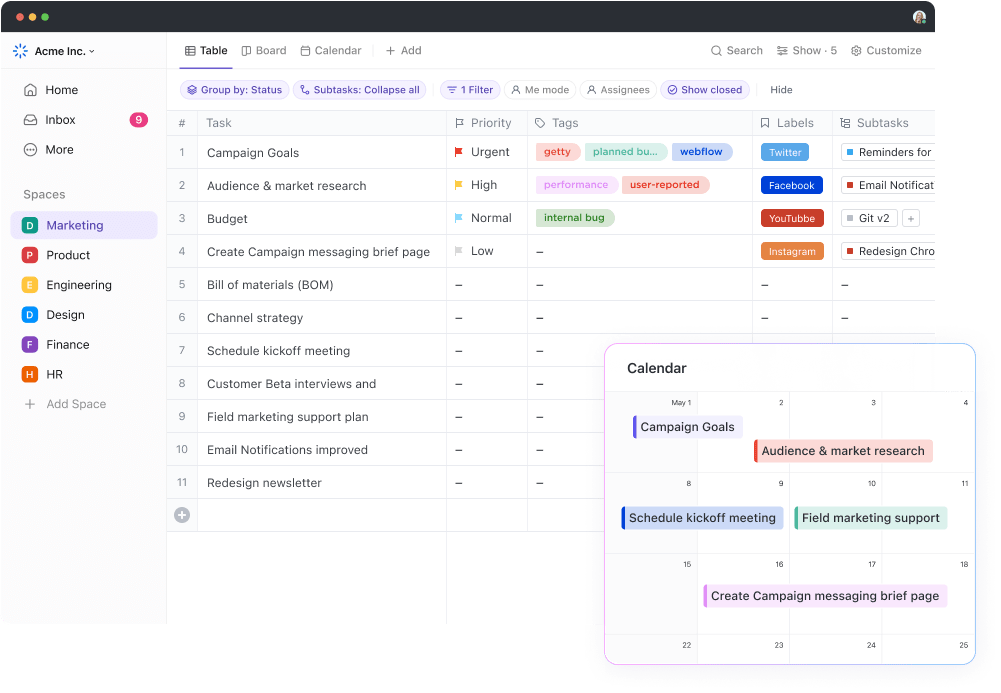
تنقّل بين عرض الجدول ClickUp 3.0 متعدد الاستخدامات وعرض التقويم لتصور جميع أعمالك بشكل أفضل
مع القدرة على إنشاء قواعد بيانات مرئية موجزة للردود التي تم جمعها، يمكن لفريقك بسهولة الحصول على صورة كبيرة لما يريده الموظفون أو العملاء حقًا. قم بإنشاء جداول بدون ترميز في غضون دقائق واستفد من أكثر من 15 حقل مخصص التي تساعدك على إضافة مجموعة كبيرة من المعلومات مثل التواريخ والحالة ومستوى الأولوية.
تساعدك خيارات التحرير الإضافية مثل التجميع وأعمدة السحب والإفلات والفلاتر على تخصيص جداولك بالطريقة التي تريدها. ✌️
إذا كنت تريد لوحة مرئية أكثر لتبادل الأفكار بناءً على الملاحظات، يمكنك تجربة ClickUp Whiteboards و الخرائط الذهنية . وسواء كنت تناقش تحديثات الميزات المخطط لها أو تضع أفكارًا بشأن خرائط العمليات الجديدة، فإن هذه الأدوات تجعل التعاون المرئي في الوقت الفعلي بمثابة نزهة في الحديقة.
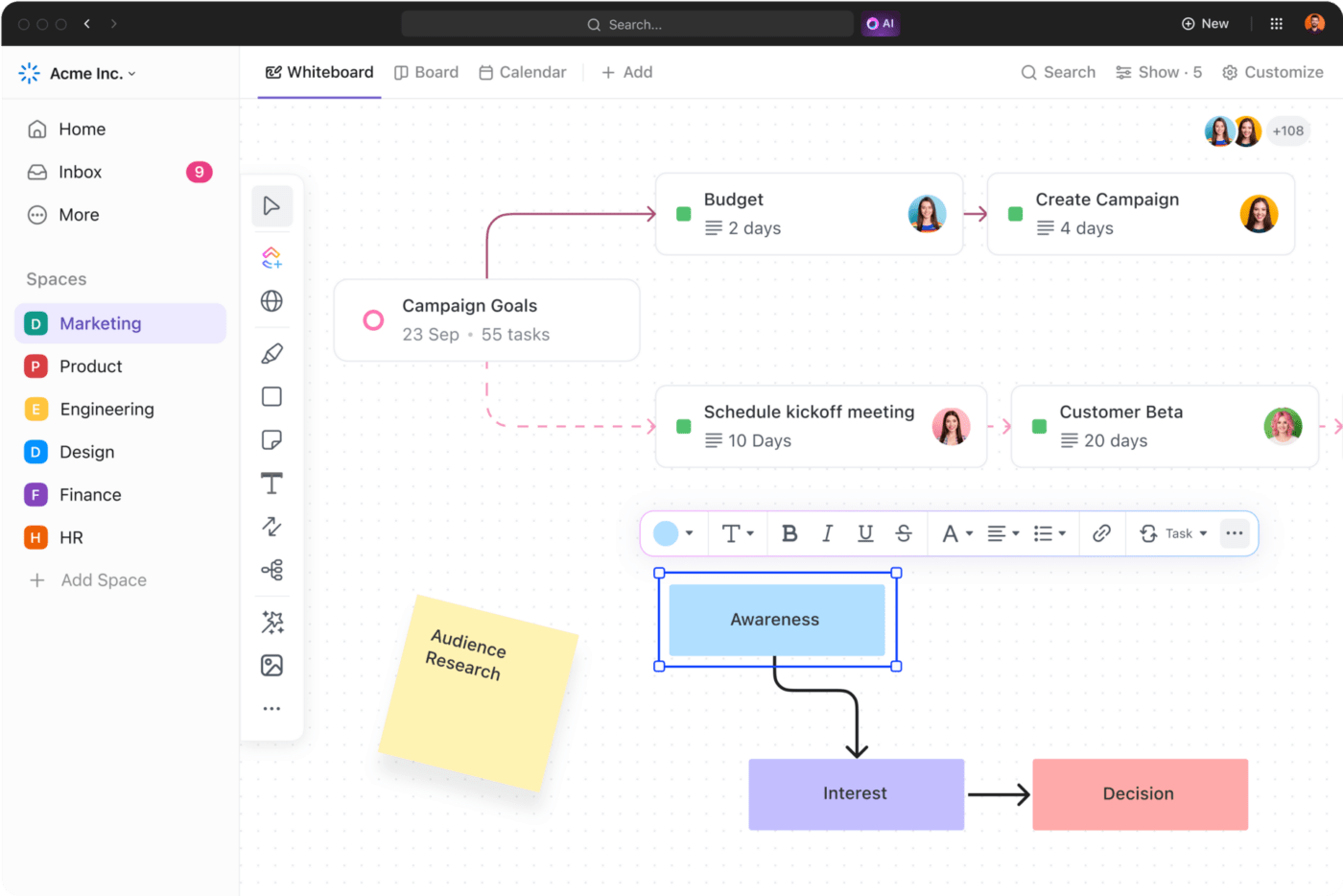
قم بالعصف الذهني أو وضع الاستراتيجيات أو تخطيط سير العمل باستخدام لوحات ClickUp Whiteboards التعاونية المرئية
الخطوة 4: تنفيذ الملاحظات والتفكير في المشاريع المستقبلية - وتكرار الحلقة إذا لزم الأمر
الخطوة الوحيدة المتبقية بعد تحليل البيانات هي تنفيذ التغييرات الواجبة. والآن، لا يمكنك الآن أن تطلب من فريقك تنفيذ التغييرات على الفور وحزم أمتعتهم والخلود إلى النوم.
بدلاً من ذلك، يجب أن تكون العملية برمتها منظمة. يجب أن يعرف كل عضو من أعضاء الفريق ما هو مسؤول عنه - على سبيل المثال، تصميم صفحة جديدة على الموقع الإلكتروني أو إصلاح خطأ مزعج في المنتج. مهام النقر فوق المهام هي بالضبط ما تحتاجه هنا! أضف عناصر الإجراءات، وقم بتعيين المهام، واترك تعليقات، وحدد الأولويات لزيادة وضوح الرؤية.
يمكنك حتى تتبع التقدم المحرز في تنفيذ التغييرات من خلال لوحات معلومات ClickUp . يمكن أن تساعدك لوحة المعلومات الشاملة على تصور الحالة المباشرة لأي مشروع عبر المخططات الخطية أو البيانية أو حتى الدائرية!

إنشاء لوحات معلومات مفصلة وإضافة بطاقات بسهولة لعرض التقدم المحرز في نقاط العدو، والمهام لكل حالة، والأخطاء لكل عرض
إذا كانت حلقات ملاحظاتك تتعلق بالمنتجات والخدمات، فسوف تستمتع بالوظائف العديدة في مجموعة إدارة علاقات العملاء الخاصة بـ ClickUp . إنه بمثابة حزمة شاملة حل إدارة العميل وهو رائع للحصول على رؤى حول العلاقات مع العملاء، وإدارة العملاء المحتملين، وتجميع تقارير المبيعات.
ابدأ رحلتك من خلال إعداد قائمة بحسابات العملاء داخل المنصة لتحسين عملية إدارة علاقات العملاء . ClickUp المدمج في أدوات إعداد التقارير تساعدك على إنشاء تقارير إدارة علاقات العملاء التي تقدم رؤى جديدة حول عمليات المبيعات والتسويق الخاصة بك.
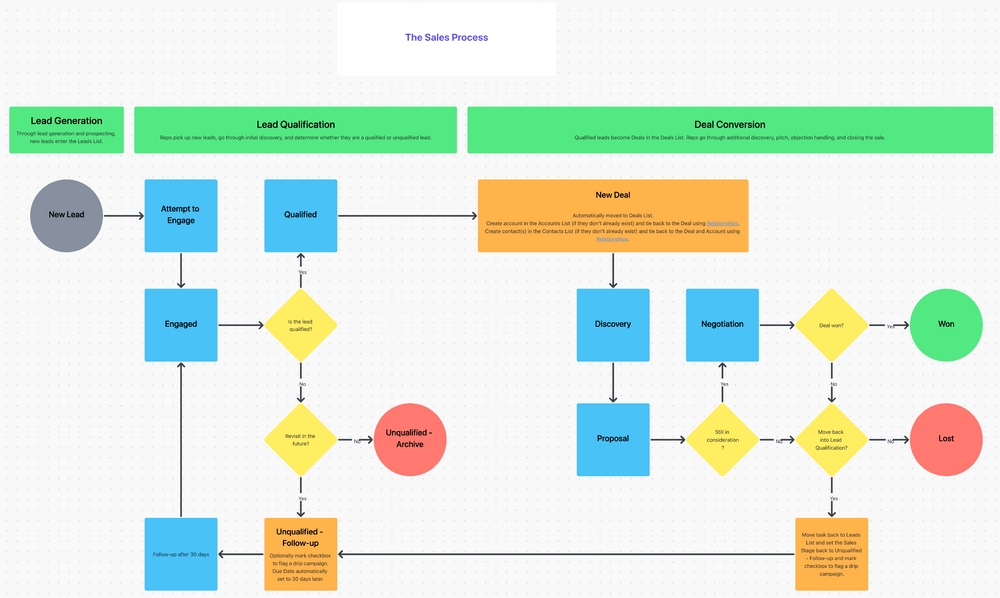
استخدام قالب ClickUp CRM في اللوحات البيضاء لتخطيط سير عمل إدارة علاقات العملاء
كيف يمكن لحلقات التغذية الراجعة مساعدة الشركات؟
تُعد حلقات التغذية الراجعة طريقة عملية للشركات للعثور على أوجه القصور في عملياتها الحالية وتحقيق النجاح التشغيلي. فيما يلي خمسة من الفوائد الأساسية:
- علاقات أقوى مع العملاء:59% من العملاء يقطعون علاقاتهم مع شركة ما بعد تجربة سلبية. تساعد حلقات التغذية الراجعة في معالجة شكاوى العملاء وتقدير آرائهم وتعزيز ولائهم من خلال تحسينات ملموسة في الخدمة
- منتجات أكثر قيمة: يساعد جمع الملاحظات - سواء كان ذلك من خلال المراجعات أو الاستطلاعات أو التواصل المباشر - في تحديد ما يحتاجه المستخدم بدقة، مما يساعد بدوره في إنشاء منتجات ومخرجات جيدة
- رضا أفضل للموظفين: تكشف حلقات التغذية الراجعة عن الثغرات وأوجه القصور، مما يتيح تبسيط العمليات وزيادة الإنتاجية في مساحات العمل
- ثقافة مدفوعة بالابتكار: يظل الابتكار محورياً للنجاح-*ما يقرب من 80% من الشركات تعطي الأولوية للابتكار لتحقيق النمو. لا تحل حلقات التغذية الراجعة مشاكل المنتج فحسب، بل تقدم أيضًا ميزات جديدة تلقى صدى لدى العملاء
- تحسين العائد على الاستثمار: يمكنكتحسين جهود التسويق والعائدات من خلال مواءمة الحملات مع تفضيلات العملاء والسماح بتدفق البيانات بشكل مستمر على القنوات المفضلة لمراقبة أنماط الشراء والاهتمامات
تسخير قوة حلقات التغذية الراجعة مع ClickUp
لتحقيق الازدهار في أي عمل تجاري، يجب عليك المزامنة مع العملاء والموظفين من خلال الاستماع والمشاركة وتوظيف رؤاهم بنشاط. تعد عمليات التحقق المنتظمة ضرورية للتوافق مع الرؤى الجديدة. لذا، ثق بأصحاب المصلحة لديك وحافظ على قربك منهم - فمدخلاتهم هي مفتاح نجاحك.
ClickUp هي واحدة من الأدوات النادرة التي تدعم كلاً من حلقات تعليقات الموظفين والعملاء ضمن حل متكامل لإدارة المشاريع. انغمس في العمل واجمع الملاحظات واجمع الملاحظات وقم ببناء المعرفة وإدارة المشاريع في خطوة واحدة. اطلع على ClickUp اليوم -نسخته المجانية رائعة جدًا أيضًا! 🤩

